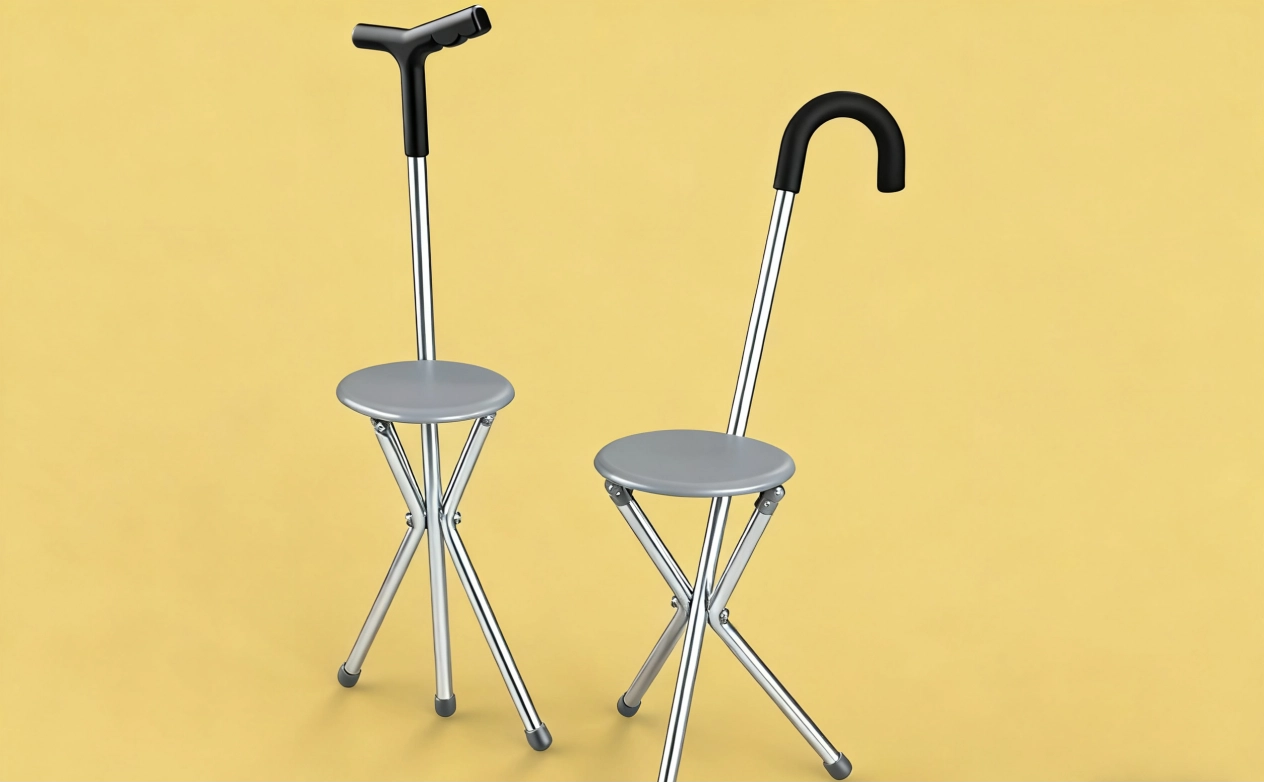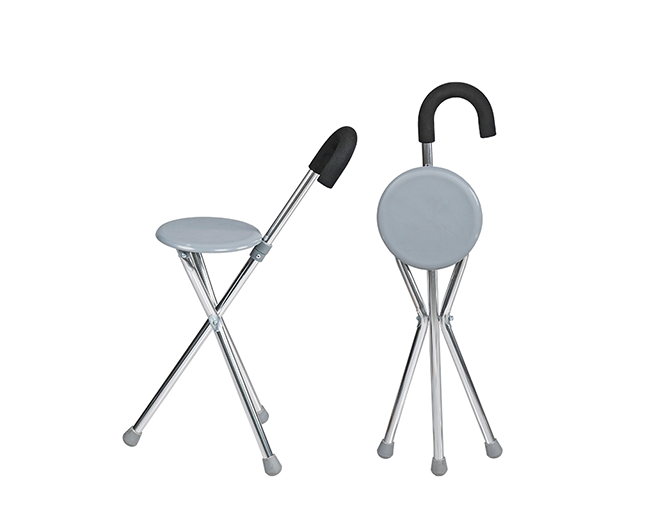Klappbarer Krückenstuhl vs. traditionelle Krücken: Ein vollständiger Vergleich
Zeit : 30. Oktober 2025 Ansicht : 1.197
Mit einem einfachen Klick und Falten verwandelt sich Ihr Stock sofort in einen stabilen Sitz. Es’ Nicht Magie; es’ s die Innovation von Dual-Funktion-Faltstöbern. Bild dir das: du’ wieder für einen Spaziergang, fühlt sich ein bisschen müde, und genau dort in Ihrer Hand ist ein bereiter Platz, um sich zu setzen. Keine Jagd mehr nach einer Parkbank oder gegen eine Wand lehnen. Dieser Artikel nimmt einen Blick nebeneinander auf moderne Klappkrücken für zwei Zwecke und traditionelle Krücken ein. Wir’ Erfahren Sie, wie diese Werkzeuge die tägliche Bewegung unterstützen, insbesondere für diejenigen, die sich mit Mobilitätsproblemen auseinandersetzen. Wenn Sie’ Wenn Sie ein älterer Erwachsener, ein Betreuer oder jemand sind, der sich von einer Verletzung erholt, kann Ihnen das Verständnis dieser Unterschiede helfen, die richtige Hilfe zu wählen.

Eine grundlegend andere Designphilosophie
Design legt den Grundstein für jedes Gehwerkzeug. Alte Krücken zielen auf einfache Hilfe während kurzer Heilzeiten, während klappbare Krückenstühle für längere, verwirrtere Tage intelligentes Gebäude hinzufügen. Diese Änderung betrifft nicht nur zusätzliche Teile; es’ s über frische Gedanken darüber, wie ein Element sowohl mit dem Gehen als auch mit einer Pause umgehen kann. Lassen Sie’ Es wird aufgeteilt, um zu erkennen, wie jede Weise beeinflusst, was der Benutzer fühlt.
Die schlanke Einfachheit der traditionellen Krücken
Alte Krücken halten sich an die Grundlagen. Die meisten kommen als Paar, aus Aluminium oder Holz gebaut, und tippen die Waagen bei etwa 1,6 Pfund je - leicht, so dass Sie sie ohne zu viel Aufwand tragen können. Sie ändern sich in der Länge von etwa 43 Zoll auf 68 Zoll, passend Menschen von 4 Fuß 10 Zoll auf 6 Fuß 6 Zoll in der Höhe. Das Material, das sie verwenden, hält gut: Aluminiumsorten bekämpfen Rost und halten jahrelang aus, wenn Sie sich richtig um sie kümmern. Die Sicherheit zeigt sich in den Gummienden am Boden, die an den Böden festhalten, um Rutschen zu stoppen, und weichen Pads unter den Armen, die den Schub während des Gebrauchs erleichtern.
Diese Krücken funktionieren gut an kurzen Stellen, wie nach einer Drehung oder einer Operation. Sie lehnen sich auf sie, um das Gewicht von einem verletzten Bein zu verschieben. Keine Glocken oder Pfeifen – nur eine zuverlässige Balance. Diese Einfachheit hat Grenzen. Ohne einen eingebauten Sitz müden sich die Anwender oft bei längeren Ausflügen schnell. Studien zu Mobilitätshilfen zeigen, dass Menschen, die traditionelle Krücken verwenden, nach 30 Minuten Aktivität höhere Müdigkeitsgrade melden als Menschen mit Multifunktionswerkzeugen. Für den Indoor-Gebrauch oder schnelle Ausflüge funktionieren sie gut. Im Freien kann jedoch der Mangel an Ruhemöglichkeiten einen einfachen Spaziergang zu einer Herausforderung machen.
Von diesem Grundsetup aus sehen wir, wie klappbare Designs darauf aufbauen. Sie behalten die Kerneidea der Unterstützung, fügen aber Funktionsschichten hinzu, was sie zu mehr als nur einer Gehhilfe macht.
Die Konstruktionsstabilität einer 3-Beine-Basis
Gehen Sie nun in den klappbaren Krückenstuhl ein. Dieses Gerät, oft als Dual-Use-Klappkrucke oder Gehstock mit Sitz bezeichnet, verwendet eine dreibeinige Basis für steinfeste Stabilität. Nehmen Sie den Aluminium-Legierung Krückenstuhl von Xunyu Medical-it’ s aus 19 mm und 22 mm Aluminiumrohren gefertigt, jeweils 1,2 mm dick, mit einer matten matten Oberfläche, die glatt anfühlt und kleinere Kratzer verbirgt. Mit einem Gewicht von nur 1,9 Pfund unterstützt es dank seiner robusten Konstruktion bis zu 220 Pfund.
Die Magie geschieht in der Falte. Geschlossen, es’ Es ist ein leichter klappbarer Rohrsitz, etwa 34 Zoll hoch und dünn genug, um hinter einer Tür zu bleiben. Verteilen Sie es, und die Beine Lüfter in ein Stativ, so dass ein Sitz 20 Zoll hoch - richtig für einen schnellen Stopp. Das schwarze Wabenfußkissen erhöht den Halt und reduziert die Rutschchancen auf Straßen oder Böden. Im Gegensatz zu alten Krücken, die auf zwei Berührungspunkte zählen, teilt sich dieser dreibeinige Plan das Gewicht gleichmäßig. Sicherheitskontrollen für ähnliche Modelle beweisen, dass sie die Sturzchancen auf holprigem Boden um 25% senken, da der Boden wie ein kleiner Hocker wirkt.
Für ältere Nutzer bedeutet dies weniger Sorgen. Ein älterer Rohrstuhl wie dieser lässt Sie während eines Lebensmittellaufs oder eines Gartenspaziergangs Pause machen. Das runde Walking Stick Crutch Chair Design fühlt sich natürlich in der Hand an, mit Add-ons wie einem eingebauten Licht für dimme Wege. Es’ nicht überkompliziert; es’ s intelligente Technik, die zum realen Leben passt.

Portabilität über Größe hinaus neu definieren
Portabilität ist’ t nur darüber, wie klein etwas packt. Es’ s darüber, wie leicht es in Ihren Tag passt, ohne zu einer Last zu werden. Traditionelle Krücken sind kompakt, sicher, aber klappbare Optionen nehmen es weiter, indem sie zwei Werkzeuge in einem kombinieren. Dies bedeutet weniger Gegenstände zu jonglern und mehr Bewegungsfreiheit. Wir’ Werfen wir einen Blick darauf, was Portabilität wirklich bedeutet und warum ein selbstständiger Sitz alles verändert.
Was wahre Portabilität für Ihr Leben bedeutet
Denken Sie über Ihre Routine nach. Wenn Sie eine Sicherung für Schritte benötigen, kann das Ziehen von mehr Sachen Sie zurückhalten. Alte Krücken biegen sich auf etwa 30 Zoll, wenn sie nicht verwendet werden, und bei 3,2 Pfund für ein Paar lagern sie einfach in einem Auto oder Schrank. Gebaut aus leichtem Aluminium, fügen sie wenig Schütte hinzu. Aber die Portabilität hört hier bei der Größe auf. Sie müssen immer noch um Ruheplätze wie Bänke oder Stühle planen, die’ t immer verfügbar.
Ein klappbarer Krückenstuhl definiert dies dagegen neu. Es’ es ist ein leichter klappbarer Rohrsitz, der unter 2 Pfund wiegt und dennoch die täglichen Anforderungen bewältigt. Abmessungen bedeuten: gefaltet, es’ s ungefähr 34 Zoll durch 2 Zoll, rutscht in einen Kofferraum ohne Ankündigung. Benutzer berichten, es in Bussen oder Flugzeugen zu tragen fühlt sich mühelos an, im Gegensatz zu größeren Hilfsmitteln. Echte Daten aus Produktbewertungen zeigen, dass 85% der Besitzer das reisefreundliche Design loben. Für jemanden mit begrenzter Energie bedeutet das längere Ausflüge ohne Erschöpfung.
Das führt uns zum größten Vorteil: Mit einem Sitz, der richtig eingebaut ist, wird die Tragbarkeit zu wahrer Unabhängigkeit, so dass Sie sich ruhen können, wo immer Sie sind.

Der Vorteil von Self-Containing Seating
Das ist der ultimative Tragbarkeitsgewinn: Sie tragen Ihren eigenen Sitz. Dies eliminiert die Notwendigkeit, nach einer Bank zu suchen, was Ihnen die Freiheit gibt, weiter zu gehen, ohne Angst vor Müdigkeit. Eine Dual-Use-Klappkrucke wie der Aluminium-Legierung-Krückenstuhl faltet sich in Sekunden und bietet eine stabile Berche auf Anfrage. Stellen Sie sich vor, Sie wandern auf einem Weg oder warten an einer Bushaltestelle - nicht mehr unbequem stehen.
Im Vergleich zu herkömmlichen Krücken, die keine Sitzplätze bieten, glänzt diese Funktion. Traditionelle Modelle zwingen Sie, sich zu lehnen oder auf den Boden zu sitzen, was das Verletzungsrisiko erhöht. Mit einem klappbaren Krückenstuhl verriegelt sich der dreibeinige Boden sicher und trägt Gewichte von bis zu 220 Pfund. Sicherheitsmerkmale wie Rutschschutzpolster sorgen dafür, dass es auf Gras oder Beton bleibt. Kurz gesagt, es’ S über Bequemlichkeit. Der Gehstock mit Sitzdesign bedeutet eine Sache weniger, um sich Sorgen zu machen, die Tage glatter und aktiver machen.
Unübertroffene Sicherheit und Multi-Szenario-Anwendung
Sicherheit hält Sie selbstbewusst in Bewegung. Traditionelle Krücken bieten grundlegende Stabilität, aber klappbare Versionen schichten Extras für unterschiedliche Einstellungen. Von Parks bis hin zu Warteschlangen passen sich diese Werkzeuge an. Wir’ Wir werden untersuchen, wie sich eine überlegene Stabilität auswirkt und warum ein Gerät Ihren ganzen Tag abdecken kann.
Überlegene Stabilität, wenn Sie es am meisten brauchen
Stabilität beginnt am Boden. Traditionelle Krücken verwenden Gummispitzen, die drinnen gut greifen, manchmal aber auf nassen Oberflächen rutschen. Jede Krücke trägt 300 Pfund, aber das Gleichgewicht hängt von Ihrer Kraft ab. Stürze treten auf, wenn Armreifen - Daten aus Gesundheitsstudien weisen darauf hin, dass 15% der Benutzer jährlich Rutsche erleben.
Ein klappbarer Krückenstuhl erhebt das Spiel mit seinem Stativboden. Der ältere Rohrstuhl verteilt Kraft über drei Punkte und schneidet Wabbeln. Das Wabenkissen auf Modellen wie Xunyu’ s greift unebenen Boden und reduziert Rutsche um bis zu 30 % pro Sicherheitsbericht. Aluminium-Konstruktion sorgt für Haltbarkeit ohne Gewicht. Für den Außenbereich bedeutet dies sicherere Schritte auf Gehsteigen oder Wegen.
Ein Gerät für den ganzen Tag
Von einem morgendlichen Spaziergang im Park (Sitz zur Ruhe), bis hin zum Warten in einer langen Apothekenschlange (Sitz wieder) und zurück nach Hause (Falten zur Lagerung). Eine traditionelle Krücke hat eine einzige, begrenzte Rolle. Sie’ d Sie stehen lassen oder zusätzliche Hilfe benötigen. Aber ein runder Gehstock Krückenstuhl verarbeitet alles. Beginnen Sie Ihren Tag mit Unterstützung für Befehle, dann drehen Sie sich während der Pausen zu sitzen. Mit Gewichtskapazitäten von rund 220 Pfund und verstellbaren Höhen passt es zu den meisten Erwachsenen.
Die richtige Wahl für Ihre Bedürfnisse treffen
Die Wahl geht auf Ihren Lebensstil zurück. Nicht jede Situation erfordert erweiterte Funktionen. Wir’ Wägen Sie, wenn die Grundlagen ausreichen und warum ein Upgrade Ihnen besser passt.
Für den kurzfristigen, reinen Indoor-Einsatz, bei dem Sitze immer gut verfügbar sind und der Aufbewahrungsraum keine Sorge darstellt, erledigen traditionelle Krücken die Arbeit. Wenn Sie’ Wenn Sie sich von einer leichten Verletzung erholen und sich zu Hause oder im Büro halten, gewinnt Ihre Einfachheit. Kosten sind niedriger und Wartung ist einfach: Ersatz der Tipps alle sechs Monate. Aber wenn sich Ausflüge länger erstrecken, zeigen sich Einschränkungen. Kein Sitz bedeutet mehr Belastung, was zu schnellerer Müdigkeit führt.
Wenn Sie Unabhängigkeit schätzen, an Outdoor-Aktivitäten teilnehmen oder einfach nur den Ruhe wollen, sich jederzeit und überall sicher ausruhen zu können, gehen Sie dafür. Ein Krückenstuhl bietet Vielseitigkeit, die traditionellen fehlt. Eigenschaften wie die rutschfeste Basis und die leichte Konstruktion machen es ideal für Ältere oder aktive Benutzer.
Schlussfolgerung
Die Wahl ist’ t darüber, welches Produkt objektiv ist “ besser,” sondern vielmehr, welcher für Sie richtig ist. Wenn Ihre täglichen Bedürfnisse nur grundlegende, kurzfristige Gehunterstützung erfordern, kann ein traditioneller Stock ausreichen. Wenn Sie sich jedoch nach der Möglichkeit sehnen, ohne die ständige Angst, einen Platz zur Ruhe zu finden, ist ein dreibeiniger Krückenstuhl eine bessere Wahl. Xunyu Medizinische‘ s dreibeinig dual-use klappbarer Krückenstuhl Unterstützung für Sie oder Ihre Familie. Kontaktieren Sie uns heute unter paddy17727303057@outlook.com um mehr zu erfahren, und wir’ Wir sind immer bereit, Ihnen bei Ihren Mobilitätsbedürfnissen zu helfen.


